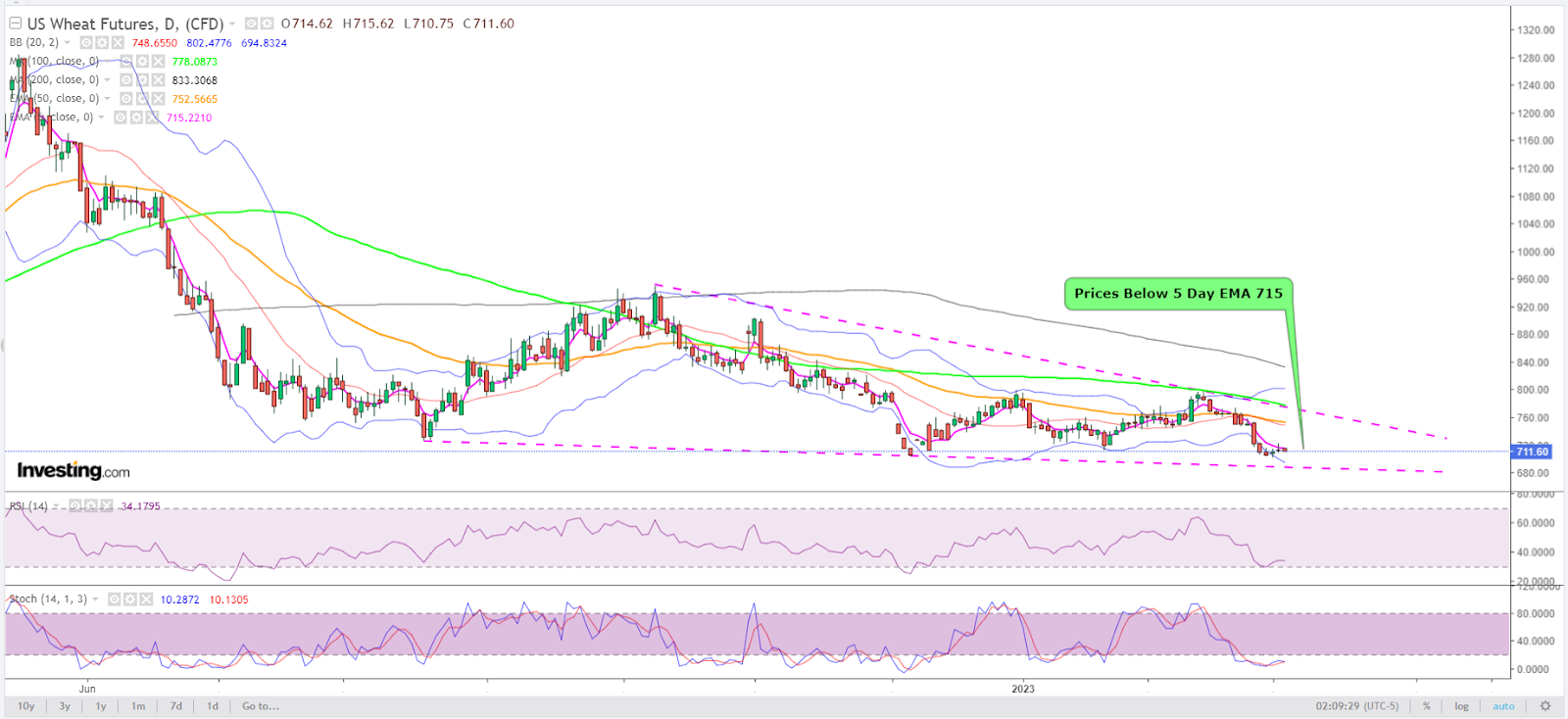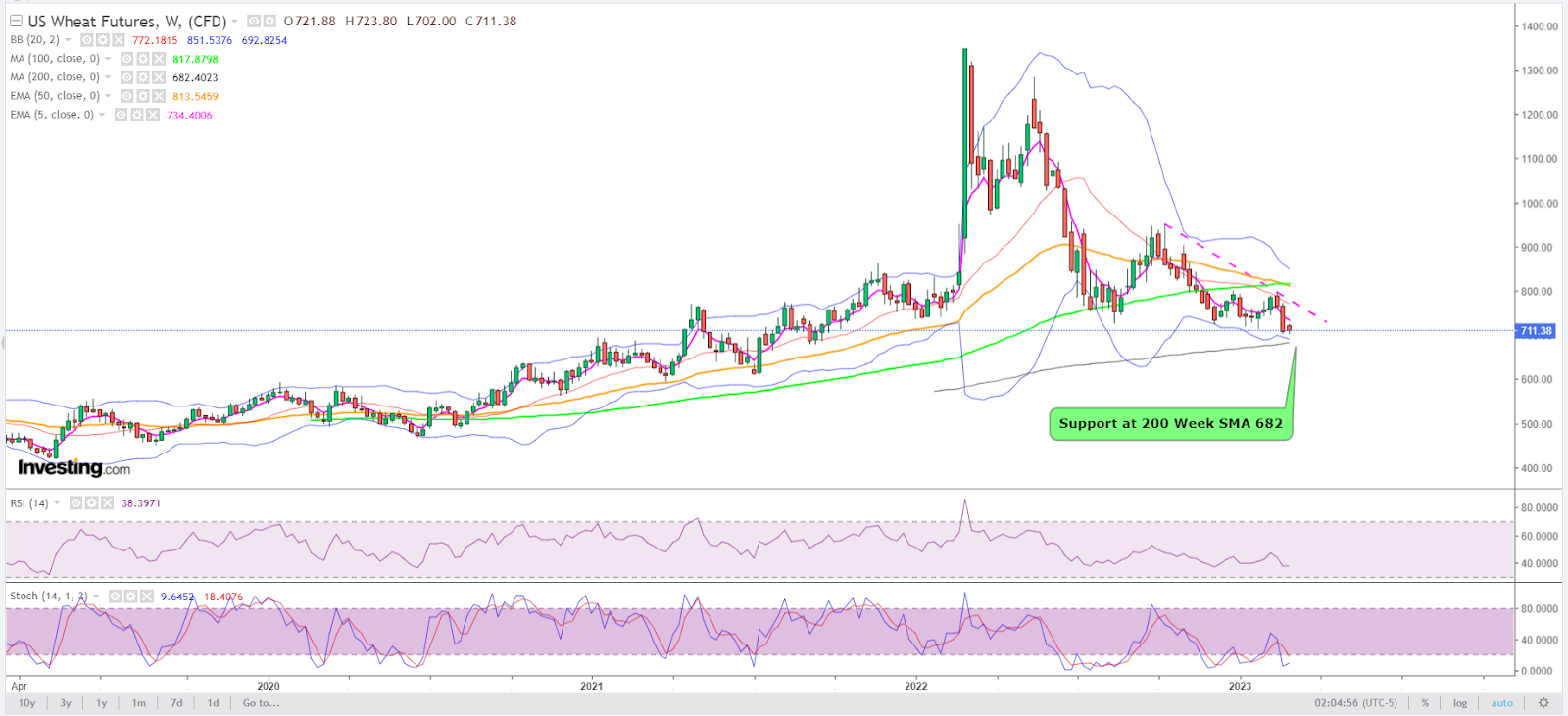- Wheat, down 23% since end-Sept, may have to lose 4% more before rebound
- Charts show a potential low of $6.82, after Thursday’s close at $7.1275
- Factors contributing to the decline include higher U.S. production, tight commodity supplies, and competition from Russia and the European Union
The people watching headline inflation at the Federal Reserve will probably be pleased that wheat prices just finished a fifth straight month lower.
The same can’t be said, though, for longs in the grain, who’ve already lost 23% since the end of September and may have to give up another quarter of that before a recovery sets in.
At Thursday’s settlement, front-month wheat for May delivery on the CBOT, or Chicago Board of Trade, settled at $7.1275 per bushel. That was down more than $2 a bushel from the September close of $9.2150.

Charts by SKCharting.com, with data powered by Investing.com
Prices of wheat — which goes into making flour, breakfast cereal, and bread, among other things — are important to the Fed because the calculus for 2023-24 involves numerous factors.
The central bank, for now, maintains an aggressive campaign to combat inflation with interest rate increases. Tied to that is a strong dollar expected to stay elevated through 2023. Costs are higher for inputs such as fertilizer. War, meanwhile, rages on in the Black Sea, a key production area. Plus, there is often the surprise in terms of crop weather. Tight commodity supplies in the past have pushed prices higher, as exemplified by the cereal and bakery products group posting a 13% increase in 2022 compared to 10% across the broader food category.
Andrew Sowell, an agricultural economist in the Crops Branch, Market, and Trade Economics Division at the Economic Research Service of the USDA, said in comments carried by Baking Business, a trade publication: “Price inflation was elevated for a broad array of products within this grouping.”
“Cereal products are normally a category that doesn’t see substantial price inflation,” said Sowell, who’s also been the coordinator of the USDA Wheat Outlook Program since June 2021. “That’s really changed a lot in the last year. That being said, demand for cereal products is generally considered to be pretty inelastic to price in the US.”
Wheat and corn stocks remain relatively tight amid a general decline for the past several years. Soybean stocks have been relatively steady but still below the elevated levels posted in 2018-19 during the U.S.-China trade war. Prices for the three major ag commodities remain elevated but down slightly from a year earlier and off the peaks registered in 2022, Mr. Sowell said.
Fighting in Ukraine pumped uncertainty and volatility into the soybean, corn, and wheat markets last year. The most substantial gains were seen in wheat, which reached historic peaks in May 2022.
Drought conditions in the U.S. southern Plains pulled prices higher still, but they began to ease when new crop wheat eased tight-supply concerns, the Black Sea Grain Initiative allowed resumed exports from the region, and Russia began a robust shipment program.
From September, though, wheat prices have consistently fallen. One reason is higher U.S. production. The USDA projects wheat acres, driven by strong pricing, to jump 3.8 million acres to 49.5 million acres, which, if realized, would be the largest in seven crop years.
Wheat yields are thought to return to trend levels following two drought years. Food use is expected to maintain a slow growth pattern along historical trend lines, while larger supplies are thought to increase feed and residual use. Wheat could be competitively priced in some locations in June, July, and August, with exports increasing but still relatively low under stiff competition. Stocks should rebound slightly but remain tight, Sowell said.
Declining U.S. market share is an important factor guiding USDA’s export expectations for wheat, corn, and soybeans, Sowell said.
“The US has lost its historic position as the world’s leading exporter. Going back 15 years, the United States had nearly 30% of the world wheat market. But now we’re only at about 10%. Russia and the European Union have been the largest exporters for much of the past decade. Australia and Canada have also been large exporters, recently surpassing the US. Wheat exports in the coming year are seen rebounding from the 51-year low we saw in the current year but will still be pretty weak by historical standards with that same competitive dynamic remaining.”
For the crop year ahead, many factors remain at play, Sowell said.
“Does drought in the Great Plains continue? What will spring wheat planting conditions be like? Will Ukraine be able to produce and export? Will we continue to see a strong US dollar? What other global supply shocks could we see? What about the weather in South America? These are all wildcards. These projections are our best estimates based on the assumptions that we have laid out.”
More importantly, it’s where wheat could technically be headed in the near term that bulls in the space may find disconcerting.
Sunil Kumar Dixit, chief technical strategist at SKCharting.com, said in an outlook posted ahead of Friday’s CBOT trading:
“Wheat is under pressure, below the 5-week EMA, or Exponential Moving Average, of $7.35 and yesterday's recovery attempts failed at $7.21.”
Dixit said all major indicators on wheat, including the RSI, or Relative Strength Index, and Stochastics were weak on the daily as well as weekly charts.
“We expect a further drop to $6.95, followed by $6.82, matching the 200-week SMA, or Simple Moving Average,” he added.
Disclaimer: Barani Krishnan uses a range of views outside his own to bring diversity to his analysis of any market. For neutrality, he sometimes presents contrarian views and market variables. He does not hold a position in the commodities and securities he writes about.
